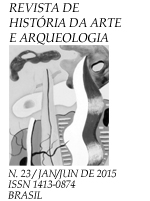Abstract
The canvas Maraba, painted in 1882 by Rodolfo Amoedo, has a peculiarity: it has a preparatory study, both works belonging to the collection of the National Museum of Fine Arts in Rio de Janeiro. Placed side by side, we perceive them as sister works, obviously, but very different in intention: while the official canvas, despite its peculiarities and displacements of its literary matrix, the homonym poem by Gonçalves Dias, intends to be a proof of the painter’s artistic advances on French soil and respecting the premises of Indianism that still captained the national artistic production in the 1880s, the preparatory study shows itself as
a wide field of semantic trials, exhibiting a provocative “mestizo” and little accustomed to the symbolisms of the homeland. This article aims to analyze and establish relations between both works and others produced in the same period, seeking to understand how the artists of Amoedo’s generation were related with nationalist legacy based on the Indian figure.
References

This work is licensed under a Creative Commons Attribution 4.0 International License.
Copyright (c) 2020 Richard Santiago Costa


